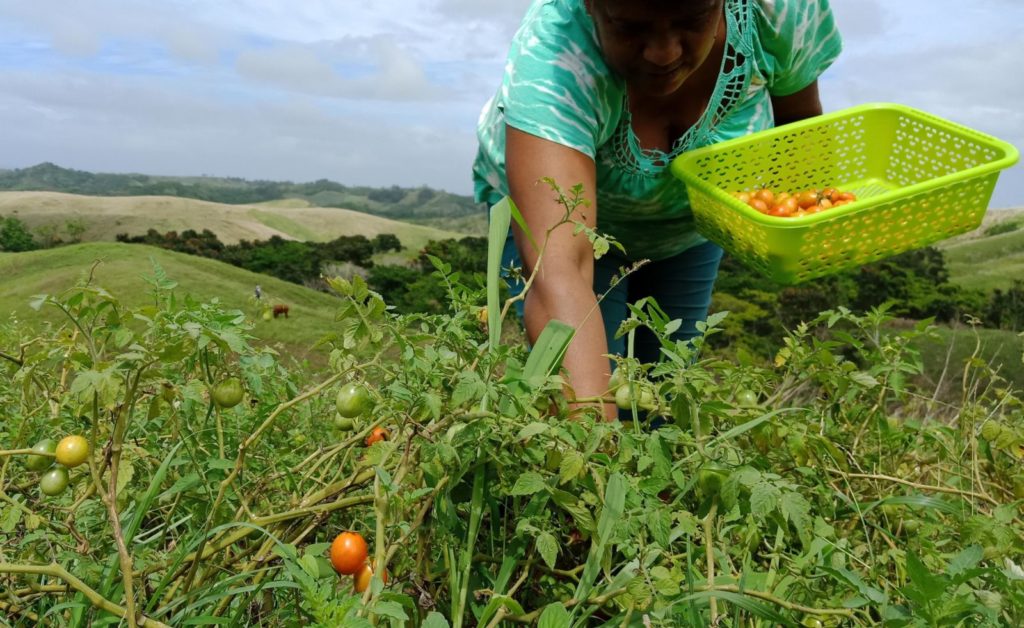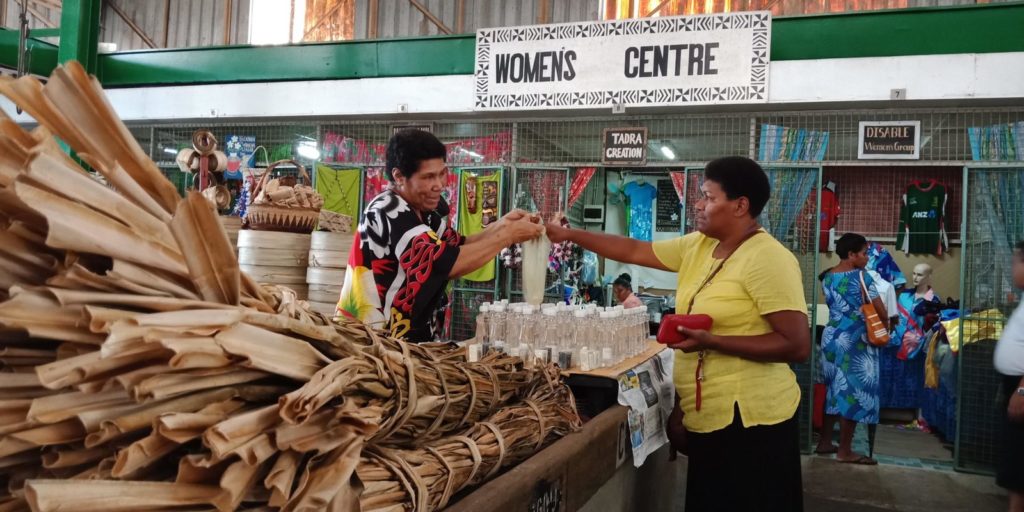
Download this and other articles about the state of social protections in the global South compiled in our latest DAWN Informs here
The adoption of the language and policies of ‘social protection’ has only recently begun to be reflected in the development thinking and practice of Pacific Island states, following their promotion by international and regional financial institutions and donor agencies as a poverty alleviation policy instrument and, since 2016, as a means of achieving both SDGs 1 (End Poverty) and 8 (Inclusive economic growth). According to Australia’s Department of Foreign Affairs and Trade (DFAT), the Pacific region’s largest donor, social protection is ‘a relatively new space for the Australian aid program, but one which is growing in importance for the Indo-Pacific region.’[1] DFAT is now pushing social protection – whether in the form of ‘cash and food transfers, an income-generating asset (such as livestock), cash for work or other transfers’ (which may be conditional upon school attendance or accessing child health services) – as ‘one of the key responses to reducing poverty and supporting inclusive economic growth’.[2] Australia’s aid program will focus strongly on ‘supporting initiatives that provide regular and predictable cash or in-kind transfers to individuals, households, and communities in our partner countries.’
The promotion of social protection with the joint aims of alleviating poverty and achieving inclusive economic growth, is premised on the notion that it will ‘unlock… the economic potential of the poorest’, and assist the poor “to purchase enough food to be able to work hard, obtain transport to access work opportunities and purchase assets to invest in income-generating activities”.[3] It’s an IFI take on the International Labour Organisation’s longstanding advocacy for strengthened social protection floors in all countries in the context of globalisation’s impacts in eroding wages and working conditions and increasing income disparities. While a global push by development banks and donor agencies for social protection for citizens in low and middle-income countries throughout their different phases of life (life cycle approach) is a welcome development in global policy thinking, it can be criticised for failing to confront the structural causes of the extreme levels of poverty and inequality we are seeing today, which lie in inequitable and impoverishing macro-economic policies. Such policies, which have been applied in Pacific Island states over the last 25 to 30 years, have resulted in substantial formal sector job losses, declining real wages and living standards, a growing dependence on informal sector livelihoods, and widening income inequality.
The idea of poverty existing in Pacific Island countries was rejected for a long time – it was argued that communal land ownership systems in Pacific Islands countries and the subsistence livelihoods that they enabled for rural dwellers meant everyone had the option of living off the land. For a growing majority in countries like Fiji, however, where urban migration has resulted in generations born and raised outside of their ancestral villages, the possibility of living off the land is more imaginary than real. It is now generally acknowledged that there is a problem of poverty, that it exists as much in rural as in urban areas, and can no longer be ignored or euphemised as ‘hardship’.
Within this context, an inventory on non-contributory social protection programmes in the Asia and Pacific was recently jointly published by the International Centre for Inclusive Growth and UNICEF, with support from the Australian Government and socialprotection.org[i]. The picture presented in the regional inventory is very diverse. Pacific Island countries which continue to be in association with a developed country (former coloniser/administrator/trustee) may enjoy a wider range and more generous social protection benefits, approximating the kinds of social support provided in the metropolitan countries to which they remain linked. The social protection regimes within other states covered in the inventory may reflect national economic capacities and/or political imperatives or political will[4].

For example, and just to give an idea of large inequalities in social provision between PICs, Cook Islands, a self-governing state in free association with New Zealand,withan estimated population of 17,700 in 2019[ii] has eight social protection programmes, costing more than NZD 35.8 million a year in total. Niue, a similarly self-governing state in free association with New Zealand, with a much lower resident population (only 1500) has six social protection programmes. As with Cook Islands, Niue as one of the three ‘realm’ countries is substantially aided by New Zealand and its generous social protection programmes are similar to those provided to New Zealanders.
On the other end of the spectrum, Kiribati, the Pacific’s largest ocean state with an EEZ that covers more than 3 million square kilometres – is one of the region’s three independent atoll states most at risk from climate change induced sea level rise. With a population of 109,693 in 2015, Kiribati has three modest non-contributory social protection programmes in place: a copra fund subsidy for copra farmers introduced in the mid 1990s, provided through a minimum purchase price for copra and costing AUD4.54 million in 2009; a monthly paid cash allowance for citizens above 65 years of age (more than 50% of whom are women) under an Elderly Fund Scheme introduced in 2004 and costing AUD2.9 million in 2016; and free education (from 2016), previously known as School Fees Subsidy, costing approximately AUD 2.3 million a year.
Fiji, with a population of close to 900,000 (World Bank 2019),is the only Pacific Island country with a longstanding state-funded welfare scheme set up initially to support destitute citizens, who originally were elderly, former indentured labourers from India, without family to support them. Fiji is also the only Pacific Island state that has a longstanding contributory National Provident Fund (based on combined contributions from employers and employees) which includes a pension option for members upon reaching the age of 55. The scheme was controversially ‘reformed’ in 2011, with a halving of pension payments, to ensure sustainability.
The inventory identifies five non-contributory social protection programmes in Fiji, costing a total of FJD83.2 million a year. They include a conditional and means-tested ‘Care and Protection’ cash transfer and food subsidy for dependent children, who must be in school and not deprived of their rights to education, health and other basic needs (introduced in 2008); a bus fare subsidy (since 2011); a Poverty Benefit Scheme (comprising a conditional cash transfer plus food subsidy and skill-training programme for which just over FJD38 million was allocated in the 2018-2019 budget), which has replaced a longstanding Family Assistance Programme run by the Welfare Department and from which women (comprising 55% of beneficiaries) primarily benefited in 2017; a social pension scheme for elderly people who have no source of income and are not recipients of any government support or of a pension (since 2013); and a food voucher for rural pregnant women who regularly visit rural facilities, to improve maternal health (since 2014).
A Fact Sheet on Social Protection in Fiji produced by the Fiji Women’s Rights Movement (FWRM) in February 2019, identifies a much broader slate of social protection schemes in Fiji, numbering 48 in total, illustrating that definitions of social protection vary considerably. Following UNESCAP’s broader, life cycle approach to social protection, FWRM’s inventory counts among Fiji’s non-contributory social protection programmes the various scholarships and tertiary education loan schemes; HPV vaccination, school health checks, cancer screening, dialysis subsidisation, and overseas referrals for treatment programmes; as well as young entrepreneurship and micro and small business grants schemes; social housing assistance, legal aid services, and family law fee waiver. This broader framing of social protection reflects very positively on Fiji.
What can we expect from the implementation of new social protection approaches in Pacific Island states? Are cash transfers just the most recent ‘fad’ in poverty alleviation (and indeed humanitarian aid) approaches, or does it hold the key to ending poverty? Can poverty and inequality be ended without changing their structural causes? The multiplier effects of conditional cash transfers are known, from the case of Brazil (under Lula’s government) to have contributed to improving the family wellbeing of the most vulnerable. But we seem unwilling to abandon dominant economic policies that have caused extreme and worsening inequality and focus on re-orienting national economies towards creating jobs, improving wages and working conditions, returning to progressive taxation and re-embracing ‘the social wage’ (free education, free health care, subsidised housing, etc) of yesteryear, to achieve a more equitable sharing of national (and global) wealth. For all of Fiji’s many social protection schemes, the minimum hourly wage of FJD2.68 provides Fiji workers with a derisory FJD107.20 for a 40-hour week, which is well below the basic needs poverty line.
The widely-varying social protection programmes
in Pacific Island states that have been detailed in the regional inventory have
emerged in different political and historical contexts. None of them were linked
in any way to an economic growth agenda. Their gender impacts have never been
assessed. New social protection programmes involving cash transfers will almost
certainly be monitored and evaluated for their social (and gender equality) as well as economic impacts. It will be
interesting to see whether, without the burden of debt and the intra-community
tensions that typically accompany micro-credit schemes, the beneficiaries of
cash transfers and other associated supports will be motivated and empowered to
self-start their own income-generating activities and climb out of poverty. It
is unlikely, however, that such new social protection approaches alone will
achieve the SDG Goal of ending poverty.
[1] https://dfat.gov.au/about-us/publications/Documents/development-cooperation-fact-sheet-social-protection.pdf
[2] https://dfat.gov.au/aid/topics/investment-priorities/building-resilience/social-protection/Pages/social-protection.aspx
[3] Ibid.
[4] The inventory takes a narrow approach to ‘reading’ or identifying ‘social protection’ in all the countries covered.
[i] Social Protection in Asia and the Pacific: Inventory of Non-Contributory Programmes (2019 ) International Policy Centre for Inclusive Growth , United Nations Development Programme (UNDP) and the United Nations Children’s Fund (UNICEF).
[ii] Government of Cook Islands Statistical Bulletin, March Quarter, 2019
http://www.mfem.gov.ck/images/Vital_Statistics_March_Quarter_2019.pdf
A further 62,000 Cook Islanders live in New Zealand https://www.newsroom.co.nz/2018/03/08/95263/cook-islands-faces-the-price-of-success
